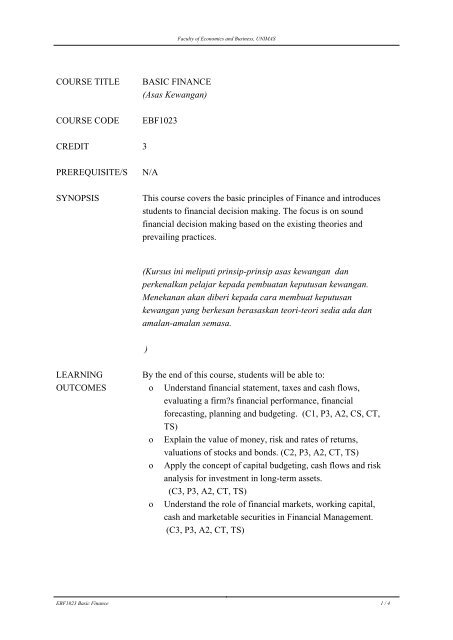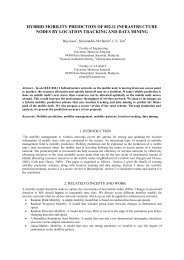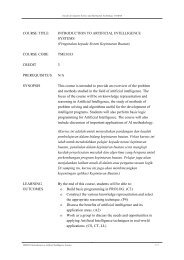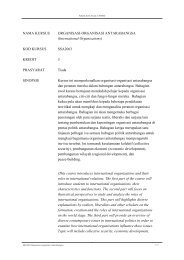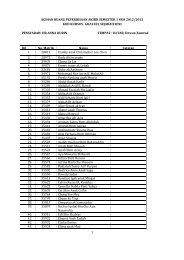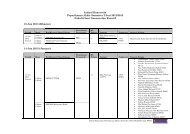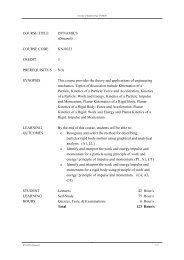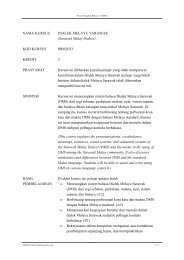COURSE TITLE BASIC FINANCE (Asas Kewangan) COURSE ...
COURSE TITLE BASIC FINANCE (Asas Kewangan) COURSE ...
COURSE TITLE BASIC FINANCE (Asas Kewangan) COURSE ...
Create successful ePaper yourself
Turn your PDF publications into a flip-book with our unique Google optimized e-Paper software.
Faculty of Economics and Business, UNIMAS<br />
<strong>COURSE</strong> <strong>TITLE</strong><br />
<strong>COURSE</strong> CODE<br />
<strong>BASIC</strong> <strong>FINANCE</strong><br />
(<strong>Asas</strong> <strong>Kewangan</strong>)<br />
EBF1023<br />
CREDIT 3<br />
PREREQUISITE/S<br />
SYNOPSIS<br />
N/A<br />
This course covers the basic principles of Finance and introduces<br />
students to financial decision making. The focus is on sound<br />
financial decision making based on the existing theories and<br />
prevailing practices.<br />
(Kursus ini meliputi prinsip-prinsip asas kewangan dan<br />
perkenalkan pelajar kepada pembuatan keputusan kewangan.<br />
Menekanan akan diberi kepada cara membuat keputusan<br />
kewangan yang berkesan berasaskan teori-teori sedia ada dan<br />
amalan-amalan semasa.<br />
)<br />
LEARNING<br />
OUTCOMES<br />
By the end of this course, students will be able to:<br />
o Understand financial statement, taxes and cash flows,<br />
evaluating a firms financial performance, financial<br />
forecasting, planning and budgeting. (C1, P3, A2, CS, CT,<br />
TS)<br />
o Explain the value of money, risk and rates of returns,<br />
valuations of stocks and bonds. (C2, P3, A2, CT, TS)<br />
o Apply the concept of capital budgeting, cash flows and risk<br />
analysis for investment in long-term assets.<br />
(C3, P3, A2, CT, TS)<br />
o Understand the role of financial markets, working capital,<br />
cash and marketable securities in Financial Management.<br />
(C3, P3, A2, CT, TS)<br />
EBF1023 Basic Finance 1 / 4
Faculty of Economics and Business, UNIMAS<br />
STUDENT<br />
LEARNING<br />
HOURS<br />
Lectures<br />
Tutorials<br />
Student-Centered Learning<br />
Self-Study<br />
Quizzes, Tests, & Examinations<br />
Total<br />
28 Hour/s<br />
10 Hour/s<br />
4 Hour/s<br />
70 Hour/s<br />
8 Hour/s<br />
120 Hour/s<br />
LEARNING<br />
UNITS<br />
Supervised<br />
Learning Hours<br />
1. An Introduction to Financial Management<br />
Definition of Finance<br />
Goal of the Firm<br />
Legal Forms of Business Organization<br />
Ten Principles of Financial Management<br />
3<br />
2. Understanding Financial Statements, Taxes, and cash<br />
Flows<br />
Measuring a Company's Profit<br />
Measuring a Firm's Book Value<br />
Computing a Company's Taxes<br />
Measuring Free Cash Flows<br />
3<br />
3. Evaluating a Firm's Financial Performance<br />
3<br />
Financial Ratio Analisis<br />
Integative Approach to Ratio Analysis<br />
4. Financial Forecasting, Planning, and Budgeting<br />
The Percentage of Sales Forecast Method<br />
The Sustainable Rate of Growth<br />
Financial Planning and Budgeting<br />
3<br />
5. The Value of Money<br />
Compound Interest and Future Value<br />
Cpmpound Interest with Nonannual Periods<br />
Present Value<br />
Ordinary Annuities and Annuaties Due<br />
Perpetuities and Infinite Annuaties<br />
Amortized Loans<br />
3<br />
6. Risk and Rates of Return<br />
6<br />
Rates of Return in the Financial Markets<br />
EBF1023 Basic Finance 2 / 4
Faculty of Economics and Business, UNIMAS<br />
The Effects of Inflation on Rates of Return<br />
Expected Return<br />
Risk and Diversification<br />
Measuring Market Risk<br />
Measuring a Portfolio's Beta<br />
The Investor's Required Rate of Return<br />
Kadar pulangan dikehendaki pelabur<br />
Pelabur dalam pasaran modal<br />
7. Valuation and Characteristics of Bonds<br />
Types, Terminology and Characteristics of bonds<br />
Definition and Determinants of Value<br />
Bond Valuation<br />
The Bondholders Expected Rate of Return<br />
Kadar pulangan dikehendaki pemegang saham<br />
6<br />
8. Stock Valuation<br />
Features and Types of Preferred Stock<br />
Valuing Preferred Stock<br />
Characteristics of Common Stock<br />
Valuing Common Stock<br />
Stockholders Expected Rate of Return<br />
6<br />
9. Capital Budgeting Decision Criteria<br />
Finding Profitable Projects<br />
Payback Period<br />
Net Present Value<br />
Profitability Index<br />
Internal Rate of Return<br />
Ethics in Capital Budgeting<br />
Capital-Budgeting Practices<br />
0<br />
ASSESSMENT Final Examination<br />
40 %<br />
Mid-term Examination<br />
30 %<br />
Case Studies/Projects and Oral Presentation 20 %<br />
Assignment<br />
10 %<br />
Total<br />
100 %<br />
EBF1023 Basic Finance 3 / 4
Faculty of Economics and Business, UNIMAS<br />
REFERENCES 1. Keown, A., Martin, J., Petty, J., and Scott, D. (2005).<br />
Financial<br />
Management (10th ed.). New Jersey: Pearson Prentice<br />
Hall.<br />
2. Van Horne, J., Wachowicz, J. (2005). Fundamentals of<br />
Financial Management (12th ed.). Essex: Pearson Prentice<br />
Hall.<br />
3. Brigham, E., Houston, J. (2007). Essentials of Financial<br />
Management. Singapore: Thomson.<br />
4. Smart, S., Megginson, W. (2009). Introduction To<br />
Financial Management (2nd ed.). Mason:<br />
South-Western-Cengage Learning.<br />
5. Saiful Bahri Sufar, Muhamad Muda & Dr. Othman Yong,<br />
(1995), Pengurusan <strong>Kewangan</strong>, Dewan Bahasa dan<br />
Pustaka<br />
Last updated: April 26, 2011, Tue, 10:50 AM<br />
EBF1023 Basic Finance 4 / 4


